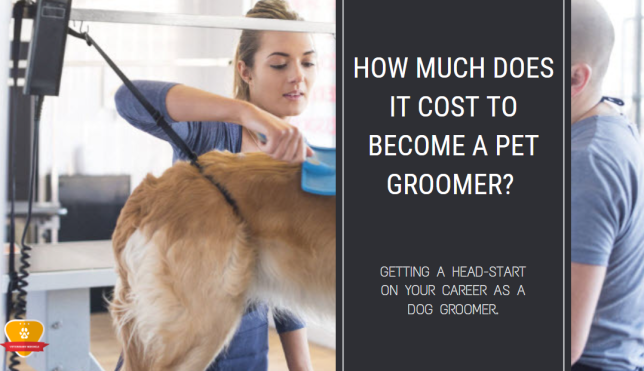- Learn online, at your own pace
- Affordable tuition with flexible payment options
- A career school accredited both regionally and nationally
- Nationally accredited and licensed college
- AVMA-CVTEA accredited Vet Tech Program taught by experienced faculty
- Get ready for certification exams recognized by the industry
Grooming refers to keeping pets looking neat and clean; trimming claws (and sometimes, beaks), fur and feathers; treating flea, tick, and parasite infestations; and checking for skin, eye, and ear problems.
Regular grooming helps pets feel comfortable with the person performing these services.
Although most groomers work with dogs or cats, others work with birds, reptiles, rodents, and rabbits.
Pet grooming takes patience, persistence, people skills, and deep love for helping animals.
Table of Contents
Pet Groomer Duties
Pet groomers do more than combing and bathing animals: for example, they must recognize the signs of illness each animal displays.
Pet stylists often notice health problems earlier than a veterinarian.
Depending on their needs, the pet groomer might see a furry or feathered family member up to twice a month.
For example, long-haired dogs or cats often need grooming every two to four weeks.
Pet groomers can prevent illness by keeping ticks, fleas, and mites off pets.
They might also notice skin problems associated with liver, kidney, or thyroid issues, leading to quicker diagnosis and treatment by a veterinarian.
Pet groomers may also discover internal parasites, so regular grooming appointments keep these infestations at bay, leading to happier pets.
Employment Outlook and Salary
With a 29 percent projected growth rate through 2031, the animal caretaker field, which includes pet groomers, has a great deal to offer.
Moreover, many animal groomers learn on the job, making it a cheaper profession to break into.
The mean annual wage for animal care and service workers is $28,730 as of 2021.
The District of Columbia and the states of Washington, California, Massachusetts, and New York offer the highest wages: $39,560 to $34,610.
So, over your working lifetime, you could earn $509,010 to $276,360 above the national average by moving.
Licensure
Although only Colorado and Connecticut license dog groomers, zoning ordinances and nuisance laws apply.
Pet Grooming Training Program Cost Considerations
Although on-the-job training seems free, nothing could be further from the truth.
Instead, you lose your time AND income from the labor you might have done elsewhere, so you must factor in lost income opportunities when deciding whether classes provide enough value.
For example, if your workplace pays pet bathers $15.00 per hour and groomers $21.00, you lose up to $48 a day.
In a year, you make $17,472 less.
Consequently, the investment in that pet grooming course looks wiser when you run the numbers.
In addition, some companies will charge you for your training if you leave or get fired.
Online Programs
American Kennel Club Canine College SAFE Grooming Program
The courses SAFE Disease and Sanitation and SAFE Handling cost $49 each.
These AKC Canine College modules provide a low-cost way to acquire the experience you need to prevent pet injuries, death, disease transmission, and other problems.
Next, take Safety in the Salon for Groomers.
This course costs $149 and covers safety protocols, best practices, and handling animals with special needs.
After those classes, proceed to the Master Groomer Certification Course Bundle, which costs $499.
It covers grooming all four standard coat types (curly, drop, jacketed, and wire) and their corresponding in-person exams.
Penn Foster Pet Grooming Certificate
This two-month program consists of 30.5 CEUs, nine courses, and 25 exams.
The program costs $549 as a single payment or $669 with the mail-in plan.
The curriculum includes equipment selection, use, and maintenance; dog and cat anatomy; pet personality types; the four steps in the grooming process; bathing and drying; and basic cutting and grooming procedures.
In-Person Training and Certification
Petco Certified Pet Stylist
This 800-hour, 20-week pet stylist program allows you to receive training while being paid a base wage of $8.25 to $10.00 an hour.
You will spend the first two weeks learning salon and safety standards while observing other stylists.
In week three, you begin supervised, hands-on training after learning to bathe and dry animals correctly.
By week 20, you must complete an exam on various breed-specific cuts.
National Dog Groomer’s Association of America
If all your training comes from work experience, taking the exams through the NDGAA will allow you to document your proficiency level.
In 1969, Robert D. Reynolds established the NDGAA to foster excellence in professional dog grooming.
In 1988, the organization began offering a National Certified Master Groomer (TM) designation and commenced holding exams, which cost $150 in advance or $200 at the door.
All practical exams include a separate written exam.
NDGAA members pay $125 per exam; testing takes an entire day.
FAQS
1. What qualities should a pet groomer display?
Pet grooming takes patience, persistence, people skills, and deep love for helping animals.
2. What groomer duty is most important?
Above all, pet groomers must recognize signs of illness or distress.
3. Where will pet groomers receive the highest pay?
The District of Columbia, Washington, California, Massachusetts, and New York offer the highest wages.
4. What if your training comes from work experience?
Taking exams through the NDGAA or the AKC Canine College will document your proficiency level.
